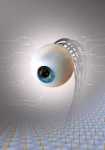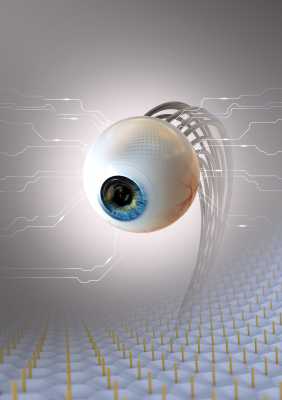
18 Jun Sci-Fi Bionic Eye Gets Closer to Reality with Curved Retina Coated with Nanowires
MedicalResearch.com Interview with:
 Prof. FAN Zhiyong PhD
Prof. FAN Zhiyong PhD
University of California, Irvine
HKUST School of Engineering
MedicalResearch.com: What is the background for this study? What are the main findings?
Response: According to the report of The World Health Organization, there are over 252 million people suffering from visual impairment globally and 15 million of them are difficult to cure by conventional medical methods. However, today, even the best bionic eyes have only 200 clinical trials, less than 1 ppm of all the patients, mainly due to their poor performance and high cost. The huge gap in supply and demand triggers the study of bionic eyes with performance comparable to human eyes. One important reason for their poor performance is the mismatch in shape between the flat bionic eyes and concave sclera. To protect the soft tissue in eyes from being damaged by the bionic surface, the implanted bionic eyes have to be small. This has limited the sensing area and further the electrodes number, and finally yielded poor image sensing characters with low resolution and narrow field-of-view.
In this work, we are trying to achieve high performance image sensing by biomimeticing human eyes. The high-density NWs are well aligned and embedded in a hemispherical template to serve as retina. The conformal attachment of bionic eyes with sclera enables the large sensing area and wide visual angle. In addition, each individual high-density nanowires can potentially work as an individual pixel. By addressing these challenges, our device design has huge potential to improve the image sensing performance of bionic eyes.
 MedicalResearch.com: How does this system differ from previous iterations and the human eye? Where might it first be deployed?
MedicalResearch.com: How does this system differ from previous iterations and the human eye? Where might it first be deployed?
Response:The main difference of our work with the previous ones are the hemispherical shape of retina and the high-density nanowires (NWs) in it. This is the first time reported on the 3D, hemispherical NW array based electrochemical eyes. In previous research, there are only a few reports on electrically functional, 3D hemispherical devices mainly due to the fabrication challenges. Compared with the limited number of previous reports, our fabrication strategy is completely differently from them and is more promising to produce high performance image sensing with long device lifetime. In specific, their devices were firstly fabricated on the flat and rigid substrates with standard planar semiconductor process and then transferred onto another hemispherical substrate. The thin layers were then deformed from a planar structure into a hemispherical structure. However, huge stress can be accumulated during the deformation process, leading to a short device life time, small pixel number and low pixel density.
In our strategy, a hemispherical nanotemplate was fabricated by deforming an Al film. There is little stress due to the high ductility of Al. The NWs were directly grown in the templates and aligned into a concave shape while maintaining its high density. Given that the single NW can serve as an individual pixel, which is already experimentally bolstered by us, this structure may lead to 3D, biomimetic eyes with high performance such as high resolution, wide field-of-view and low aberration.
MedicalResearch.com: What should readers take away from your report?
Response: The take-away message from our report is that we have developed the first 3D, hemispherical NW array based biomimetic eye which has huge application potential in vision restoration.
MedicalResearch.com: What recommendations do you have for future research as a result of this study?
Response: For applications in electronics/robotics, we will need to further increase the back contact electrode density to improve the resolution. And for visual prosthesis, in our future research, we plan to modify our device using more biocompatible materials and perform in vitro and animal tests to verify the function of our artificial retina as an implanted device. If these steps are smooth, we will proceed to clinical verification process.
Any disclosures?
Response: Before our paper went online, we have filed patents to protect our IP.
Citation:
Gu, L., Poddar, S., Lin, Y. et al. A biomimetic eye with a hemispherical perovskite nanowire array retina. Nature 581, 278–282 (2020). https://doi.org/10.1038/s41586-020-2285-x
https://www.nature.com/articles/s41586-020-2285-x#citeas
The information on MedicalResearch.com is provided for educational purposes only, and is in no way intended to diagnose, cure, or treat any medical or other condition. Always seek the advice of your physician or other qualified health and ask your doctor any questions you may have regarding a medical condition. In addition to all other limitations and disclaimers in this agreement, service provider and its third party providers disclaim any liability or loss in connection with the content provided on this website.
Last Updated on June 18, 2020 by Marie Benz MD FAAD
